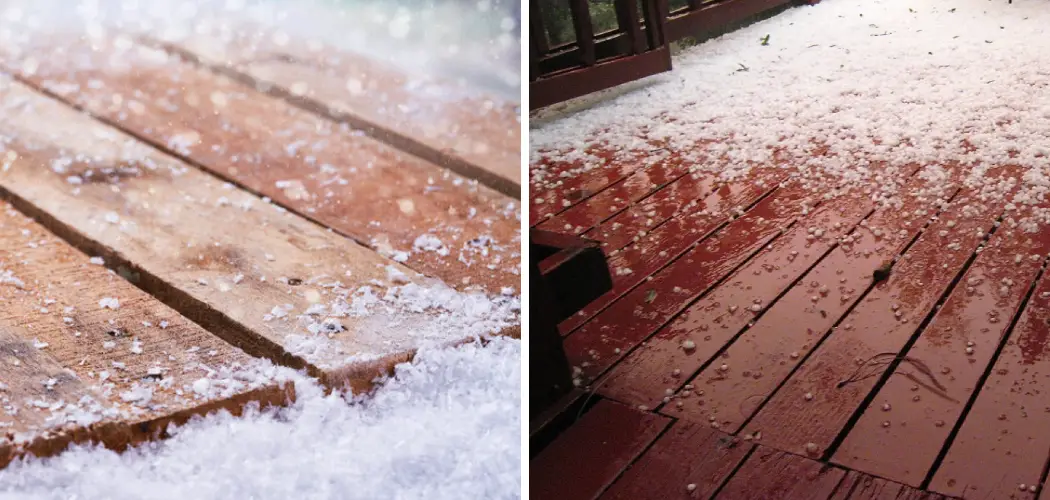Are you tired of slipping and sliding on your deck every winter? Don’t worry; you’re not alone—many struggle to keep their decking safe and slip-free during the colder months.
The combination of wet weather and low temperatures can make wood surfaces prone to becoming slippery.
Winter brings with it a variety of weather challenges, and one problem more homeowners struggle with is keeping their decking safe in wet or icy conditions. Whether you are walking on a wood deck or composite material, slipping presents an obvious safety risk for everyone – regardless of age. But how do you navigate this tricky situation?
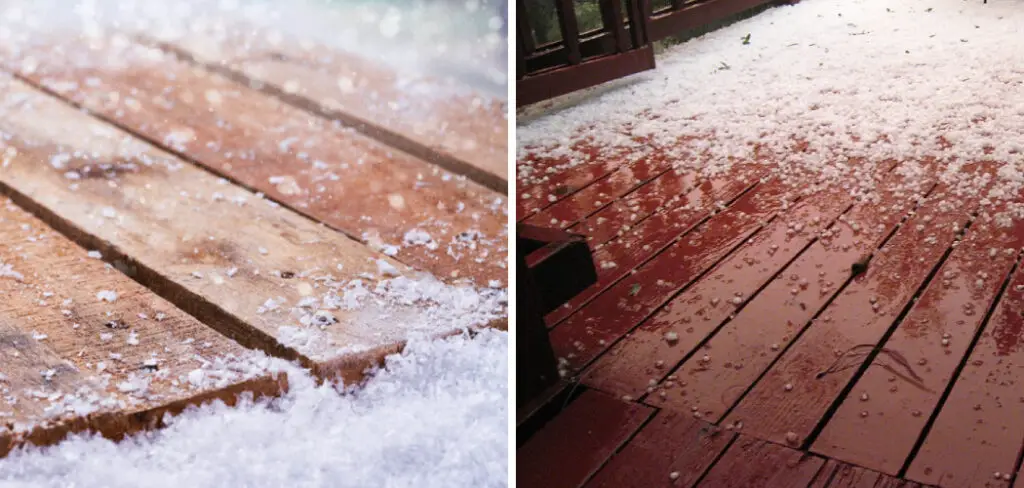
In this blog post, we’ll be exploring the best strategies for how to stop decking being slippery in winter. With smart planning, simple solutions, and regular maintenance, you can take the hassle out of slippery decking once and for all!
What Will You Need?
Before we dive into the solutions, it’s important to have some essential supplies on hand. These will not only help you combat slippery decking but also keep your deck in top shape throughout the winter season. Here are some items to consider adding to your toolbox:
- Broom: A good-quality broom removes leaves, ice, and snow from your decking.
- Anti-Slip Tape: This heavy-duty tape is an easy and quick solution for adding grip to your deck’s surface.
- Deck Cleaner: Regularly cleaning your decking will help prevent algae, moss, or mildew growth that can make it slippery.
- Sealant/Stain: Applying a sealant or stain to your decking makes the surface less prone to becoming slippery in wet conditions.
Now that you have your supplies ready let’s explore some strategies to stop decking from being slippery this winter!
10 Easy Steps on How to Stop Decking Being Slippery in Winter
Step 1: Regularly Clean the Deck
The first step in preventing your deck from becoming slippery is to keep it clean. Regularly sweep away leaves, dirt, and debris using your broom. These elements can retain moisture, leading to mold and mildew growth making your decking slippery. Additionally, use a deck cleaner to remove any stubborn grime or algae. This initial step is crucial in maintaining the grip of your deck surface and keeping it slip-free during winter.
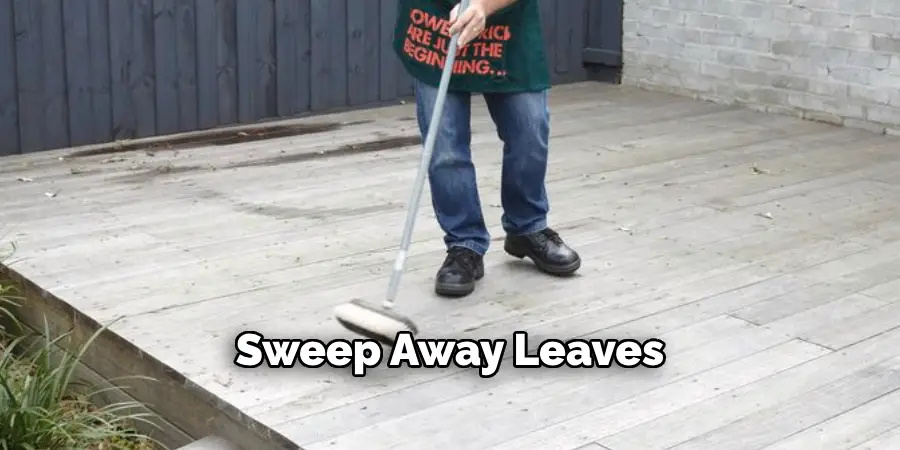
Step 2: Apply Anti-Slip Tape
Anti-slip tape is a simple and cost-effective solution to a slippery deck. It’s a heavy-duty tape with a strong adhesive on one side and a rough surface on the other. Apply the tape along the length of your decking planks. This will create a non-slip surface, significantly reducing the risk of slipping. Ensure the deck is dry and clean before applying the tape to ensure it adheres well. Also, replace the tape regularly to maintain its grip.
Step 3: Apply a Non-Slip Decking Stain or Sealant
After cleaning your deck and applying anti-slip tape, consider using a non-slip decking stain or sealant. These products contain tiny particles that create a rough surface, increasing traction and reducing the likelihood of slipping. Before application, ensure your deck is clean and dry.
Apply the stain or sealant evenly with a brush or roller, and let it dry thoroughly. Regularly reapply the product according to the manufacturer’s instructions to maintain a non-slip surface throughout the winter.
Step 4: Install Decking Mats or Outdoor Rugs
Decking mats or outdoor rugs can be a great way to add extra grip and reduce slipperiness on your deck. These mats are specifically designed for outdoor use and have a non-slip surface. They can be strategically placed on high-traffic areas of your deck to prevent slips and falls.
Ensure to secure them properly so they don’t move around, and choose designs that are suitable for outdoor use and can withstand harsh weather conditions. Remember to clean these items regularly to prevent mold or mildew from growing underneath them.
Step 5: Sprinkle Sand or Salt
In colder climates where your decking may become covered in snow or ice, it can be beneficial to sprinkle sand or salt on the surface. This will help to melt the ice and provide additional grit to the surface, reducing the risk of slips and falls. Be sure to choose an eco-friendly option that won’t harm your decking or the surrounding plants. After the ice has melted, sweep away the remaining sand or salt to avoid any potential damage to the decking material.
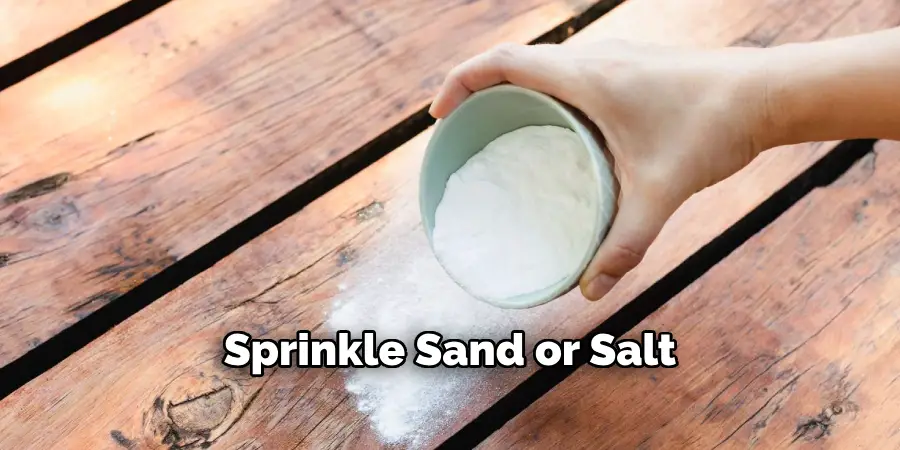
Step 6: Use an Outdoor Heater or Heat Strips
Another helpful strategy to prevent your decking from becoming slippery in winter is to use an outdoor heater or install heat strips. Outdoor heaters can help to keep the deck warm, preventing the accumulation of frost or ice. Alternatively, heat strips can be installed directly on the deck surface. They heat up to melt the snow or ice, helping to keep the deck slip-free. Always follow the manufacturer’s instructions for installation and use to ensure safety.
Step 7: Regular Checks and Maintenance
Maintaining a routine check of your deck throughout the winter months is vital. Look for signs of wear and tear, algae or moss growth, and replace any damaged or worn-out anti-slip tape or mats. If you have applied a non-slip stain or sealant, monitor its effectiveness and reapply when necessary.
Remember, it’s easier to prevent your deck from becoming slippery initially than trying to deal with a dangerously slick surface. Through regular upkeep, you can ensure your decking remains safe and slip-free throughout the winter season.
Step 8: Improve Lighting
Good visibility is crucial to prevent slips and falls, especially during the shorter winter days. Therefore, consider installing outdoor lighting around your deck. Whether it’s path lights, deck post lights, or string lights, they can dramatically improve visibility and add an element of safety. When choosing lights, consider those suitable for wet and cold conditions and consider solar-powered options for an eco-friendly choice. Regularly check and replace any burnt-out bulbs to ensure your deck is well-lit throughout the winter months.
Step 9: Install Handrails
Installing handrails can be a considerable safety measure, especially during icy conditions when the risk of slipping increases. Handrails provide additional support and balance, reducing the chance of falls. Depending on your deck’s size and configuration, you may install handrails around the entire deck or just in high-traffic areas.
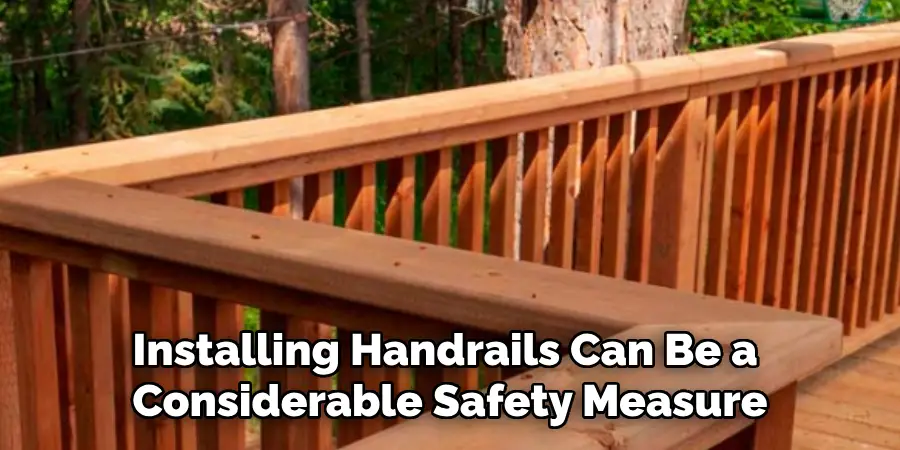
Choose handrails that are sturdy, weather-resistant, and blend well with your deck’s aesthetic design. Ensure they are installed securely and at an appropriate height to provide adequate support.
Step 10: Seek Professional Advice
If all else fails, or if you need more confidence in handling the task yourself, consider seeking professional advice. Many companies specialize in deck maintenance and safety, and they can provide expert recommendations tailored to your specific decking material and climatic conditions. They can also help in the application of unique treatments or the installation of safety measures. Remember, the safety of you and your family is paramount, and sometimes, it’s worth investing a little extra to ensure your decking is safe and slip-free during the winter.
By following these steps, you can prevent your decking from becoming slippery in winter and enjoy a safe and enjoyable outdoor space all year round. So don’t let the fear of slips and falls keep you from enjoying the beauty of your deck during the colder months.
5 Additional Tips and Tricks
- Algae Removal: Algae growth can significantly contribute to a slippery deck. Regular cleaning with a deck cleaner can help remove algae and prevent its regrowth.
- Use of Anti-Slip Strips: Anti-slip strips are easy to install and provide extra grip, reducing the slipperiness of the deck.
- Pressure Washing: A good pressure wash can remove grime and slippery substances from your deck. However, be careful not to use too high a pressure as it may damage the wood.
- Applying Non-Slip Paint: There are specially formulated paints available that provide a non-slip surface when applied to decking.
- Keep your deck free of debris and leaves: In winter, it is essential to regularly sweep off any debris or leaves that may accumulate on your deck. Wet and decaying leaves can create a slippery surface.
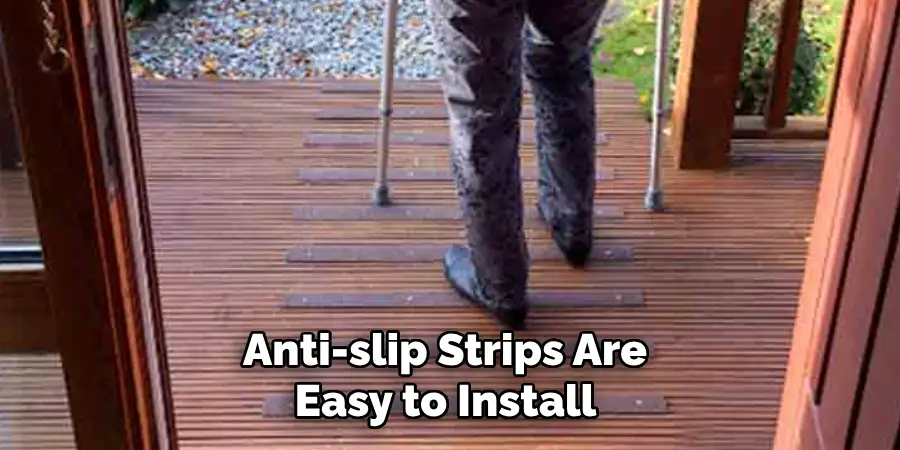
By following these additional tips and tricks, you can further prevent the slipperiness of your decking in winter.
5 Things You Should Avoid
- Avoid Neglecting Regular Maintenance: Regular maintenance is key to a safe, non-slippery deck. Failing to clean or treat your deck routinely can lead to the build-up of algae, moss, or other slippery substances.
- Avoid Using an Excess of Water: While cleaning your deck, avoid using excessive water as it can seep into the wood and cause it to become slippery when frozen. Use just enough water to clean and let the deck dry thoroughly.
- Avoid Leaving Snow Piled Up: Snow left to pile up can compact into ice, creating a highly slippery surface. It’s best to shovel snow off the deck promptly.
- Avoid Using the Wrong Cleaning Products: Certain cleaning products can leave a slippery residue on the surface of the wood. Always select products specifically designed for decking.
- Avoid Ignoring Weather Forecasts: Keep an eye on the weather forecast during the winter months. Treating your deck before heavy rain or snow can help prevent it from becoming slippery.
By avoiding these common mistakes, you can further enhance the safety of your deck and ensure it remains non-slippery throughout the winter months.
Conclusion
As you can see, there are several different ways how to stop decking being slippery in winter. Taking the time to address these issues can save you from a nasty accident. With the right steps, you can keep your deck safe and usable all year.
Investing in surface protectors, sealants, and coatings, as well as using traction grits and items like rugs and mats, will help ensure your deck is kept safe for everyone who uses it over the slippery winter months. In addition, remember that regular maintenance throughout the year may be necessary to prevent slipperiness caused by the wear and tear caused by snow and ice throughout wintertime.
Don’t hesitate to take action now so that everyone who comes onto your property will stay safe during those cold months!
About
Outdoor Fixes is a distinguished figure in the world of Diy design, with a decade of expertise creating innovative and sustainable Diy solutions.
His professional focus lies in merging traditional craftsmanship with modern manufacturing techniques,
fostering designs that are both practical and environmentally conscious. As the author of diy,
outdoorfixes delves into the art and science of outdoorfixes-making, inspiring artisans and industry professionals alike.
Education RMIT University
(Melbourne, Australia) Associate Degree in Design (Outdoor Fixes) Focus on sustainable design, industry-driven projects,
and practical craftsmanship. Gained hands-on experience with traditional and digital manufacturing tools, such as CAD and CNC software.
Nottingham Trent University
(United Kingdom) Bachelor’s in outdoorfixes.com and Product Design (Honors) Specialized in product design with a focus on blending creativity with production
techniques. Participated in industry projects, working with companies like John Lewis and Vitsoe to gain real-world insights.
Publications and Impact
In diy, Outdoor Fixes his insights on indoor design processes, materials, and strategies for efficient production.
His writing bridges the gap between artisan knowledge and modern industry needs, making it a must-read for both budding designers and seasoned professionals.

